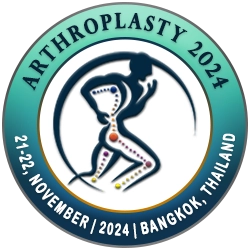
Belyaeva E.A
Tula State University, Russian FederationTitle: Comparative effectiveness of intraarticular administration of hyaluronic acid preparations: practical results and theoretical justification
Abstract
A wide use of hyaluronic acid drugs in osteoarthritis treatment is justified by the fact that it possesses antipathogenic, anabolic, anti-inflammatory, and antinociceptive effect. Hyaluronic acid drug use is most preferable among comorbid patients and those with contraindications to NSAID and local glucocorticosteroids. Effect of hyaluronates can’t be explained merely by mechanical reasons, as the process of drug degradation is calculated in days, while treatment effect lasts for several months, that allows to speak about pathogenetic action at cell and tissue levels.A 12 week single-center, prospective, randomized trial was held to evaluate comparative effectiveness of hyaluronic acid drugs. The patients, aged not more than 50 (from 43 to 50), experienced pain syndrome intensity of about 40 mm on average according to visual analogue scale. Most patients in all groups had radiological stage II of osteoarthritis according to Kellgren-Lawrence. Osteoarthritis disease duration was less than 10 years. Arterial hypertension was the most frequent concomitant somatic disease. Three drugs for intraarticular administration (injection), such as Armaviscon Forte (sodium hyaluronate 2.3 % - 3 ml), Flexotron Cross (bionic cross-link 2 % - 3ml), and Flexotron Ultra (linear hybrid dual action sodium hyaluronate 2.5 % - 4.8 ml), were chosen to realize ( fulfill) research goal. The difference of an early analgesic effect can be explained by a more pronounced anti-inflammatory action of hyaluronic acid, unmodified with cross-link communications, which is realized immediately after drug administration into the joint. A cross-linked hyaluronic acid has a delayed but prolonged effect, as viscoinduction is expressed, to a greater extent, due to its slower decay by hyaluronidase and extention of stay in the joint, increased resistance to chemical and mechanical load. A high single dose, injected into the joint, at one time has a quick and prolonged effect due to a more pronounced action, regeneration boost of rheological properties of endogenous and synovial fluid and reparative tissue regeneration and cell differentiation induction.
Biography
Doctor of Medicine (Doctor of Medical Sciences), Professor of internal diseases department of Medical Institute, Tula State University since 2011. She has been a practicing rheumatologist since 1996. Professor conducts research activities on osteoarthritis and osteoporosis problems and has got more than 200 scientific publications. She is a chief editor of “Clinical Medicine and Pharmacology” journal.

